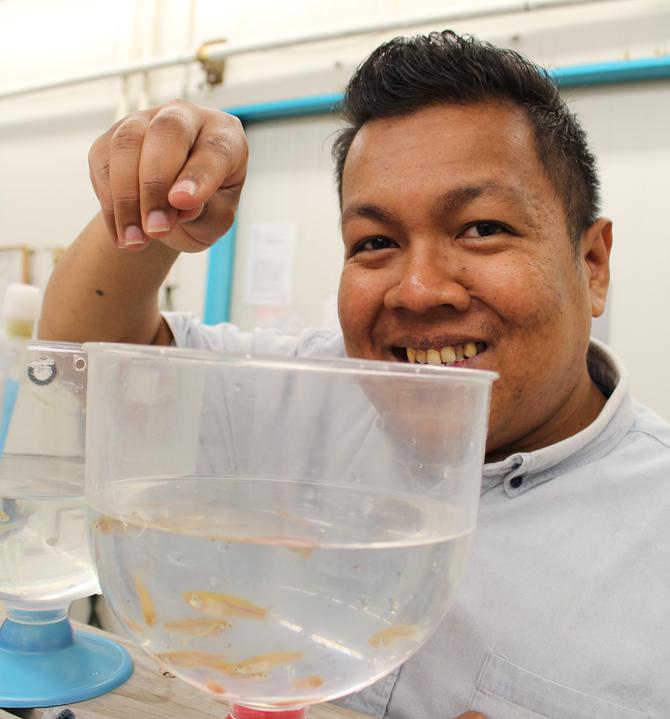Malaysian scientist Dr Lokman Norazmi completed his PhD at the Institute for Marine and Antarctic Studies in mid-2016 after four years’ study in Launceston into how to eradicate the tiny Gambusia, an unwelcome guest from North America that could be sued for false advertising.
Commonly known as the mosquitofish, the Gambusia was introduced to Australia in the 1920s in the mistaken belief that it would help to control mosquitoes and the spread of malaria.
Once here they ate anything but mosquito larvae, and Lokman says that as a result they’re a threat to native species of fish and frogs such as galaxiids, and golden and green bellfrog in Tasmania, where they’re found in wetlands along the Tamar River near Launceston.
“Although they are very small, they are also very aggressive. Not only do they compete for food, but they also attack local fish and frogs, especially tadpoles.
There are more than 38 local fish and frogs that are currently being threatened in Australia.
Working with his supervisors and long-time Gambusia researchers, Associate Professor John Purser and Dr Jawahar Patil, Lokman’s PhD studies focused on using the Gambusia’s own chromosomes to eradicate it.
“We are trying to develop a Trojan Y female. This is a female fish physically but genetically they have the YY chromosome.
“We hope that when we introduce this YY female into the wild they produce a male-biased population. When there are too many males it will collapse the whole population.
“Through my research we’ve managed to collect a lot of reproductive biology information that has never been reported before.
“This fish is quite amazing. The female can store sperm and from one mating they can produce up to nine broods. When they give birth, the largest clutch size that we have observed is about 280 fish."

Having graduated in August, Lokman will now use his research to tackle Gambusia back home in Malaysia, where they’ve been identified in two major dams.
“In Malaysia there has not been much focus on invasive species. My plan is to go back home and see what I can do."
Lokman will maintain his ties with IMAS, and will continue to research Gambusia with John Purser and Jawahar Patil.
Lokman has also continued a family tradition of studying at the University of Tasmania, following in his aunt’s footsteps almost 20 years later.
“My auntie studied Law in Hobart, which meant I had seen a lot of photos of Tasmania of my auntie and my grandad when he visited her.”
Lokman says the choice to study at the University of Tasmania was an easy one. As a requirement of his work, Lokman needed to pursue a PhD and had always known he wanted to study in Australia.
I went to a few education exhibitions in Malaysia and spoke with my colleagues, my seniors, and whenever I mentioned my field, the first university people said was the University of Tasmania.
“When I arrived in Launceston and first looked out my flat window it was so green compared to Melbourne or Sydney. The state is beautiful, peaceful, it’s a really good place to study – less distractions. If I am stressed I’ll go to the Cataract Gorge for a bushwalk”
After settling into life in Launceston, meeting his supervisors and seeing the aquaculture centre Lokman began to really love his new life.
I think I made a really good decision coming to Tasmania, and academically, the support and facilities have really helped help me to become an independent researcher. I have lots of friends who are studying Fisheries and Aquaculture at other universities in NSW and SA, and even they say that I am lucky to be at the University of Tasmania.
On top of support and facilities, Lokman rates the opportunities for community outreach and collaboration with government and non-government organisation as key to his success.
I had the opportunity to work with NRM North and the Tasmanian Government Inland Fisheries Service, plus participating in outreach with the community and teaching. These opportunities have helped me in gaining lots of experience, more than I expected. These experience will help me when I return to work in Malaysia.
By completing his PhD Lokman can transition from his previous role as a junior lecturer to a senior lecturer. His Malaysian university, Universiti Malaysia Terengganu, has a growing relationship with the University of Tasmania and signed an MoU in 2015.
Eradicating a major fish pest in both countries would be a welcome outcome of their research collaboration.
How to follow in Lokman’s footsteps
If you have completed a Bachelor degree, study the Master of Applied Science (Marine Environment) with Honours – two years full time (Launceston).
If you have completed an Honours or Masters degree, study a Research Higher Degree at IMAS in either Hobart or Launceston.
Interested in conducting your own research? Apply now to become a research student.